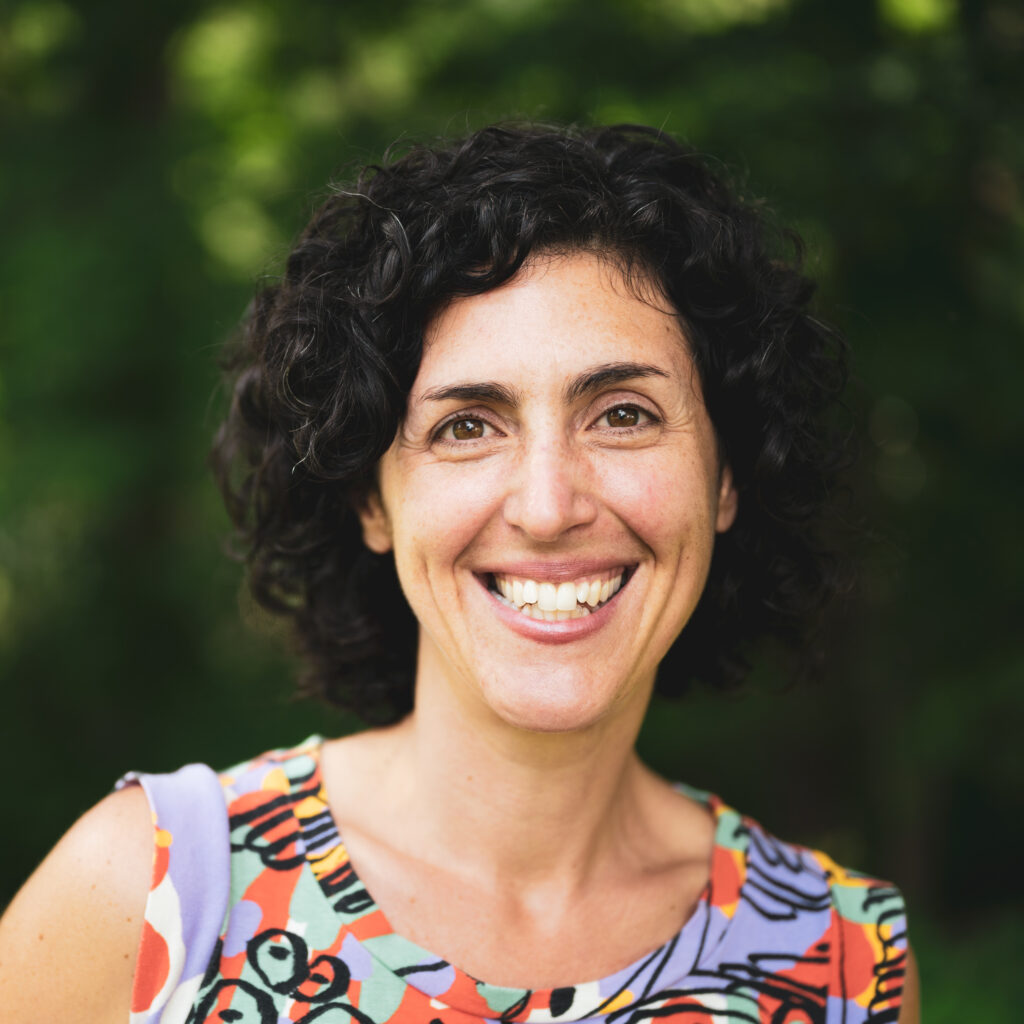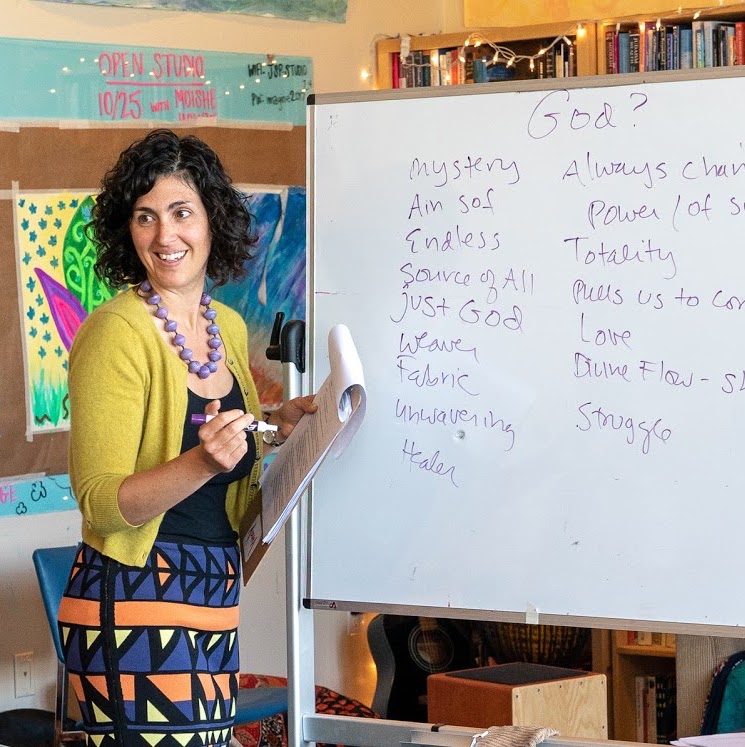Stretching the Canvas of Interpretive Possibilities: Adina Allen

Sacred Jewish text study has been an intellectual pursuit for centuries, and Rabbi Adina Allen, cofounder and creative director of the Jewish Studio Project (JSP) in Berkeley, California, is committed to expanding beyond that modality.
“You can’t separate the emotional component from what it means to study Jewish texts,” said Allen. For Allen, the daughter of art therapy pioneer Dr. Pat Allen, the way to integrate an emotional connection to text study is through creativity and art-making. “When we bring the fullness of our life experiences into conversation with sacred text, we make space for new stories, insights, images, and questions,” she said. The innovative Jewish Studio Process methodology that Allen created in 2015 along with her husband, Jeff Kasowitz, has enabled thousands of learners to discover new ways of encountering and exploring text.
The inspiration for Allen’s work was planted during her childhood in suburban Chicago. “Whenever I had a challenge, my mother would ask me if I had made art about it,” said Allen. “My mother was empowering me to understand that answers exist within me and that art-making is a way to discover them.”
During her senior year of college at Tufts, when she needed a way to explore her own sense of devastation raised by a course about climate change, Allen adapted what she learned from her mother. Together, mother and daughter spent hours in their home studio in a process that helped Allen absorb what she was learning.
“The practice of art-making allowed me to create a space in which to be with my own sadness in response to what I was learning,” she said. “I wondered how art-making could be used to make space for our feelings and to process the emotional component of intellectual work.” Allen replicated the creative art-making and reflection process at a symposium on campus where her body of work was shared, and the response was encouraging.
When Allen entered rabbinical school at Hebrew College, she fell in love with the beit midrash. “I felt so stimulated by the pedagogy of havruta and the way it democratized the learning process,” said Allen. “We were being told that we are the commentators of today, and I began asking how to offer ways for these texts to speak uniquely to our life experiences.”

“How can we bring intuition, creativity to the fore,” Allen wondered. “How can we elongate our experience with the text?” She tried an experiment with her classmates and faculty where they combined some of the familiar components of traditional text study—starting with a question, paired havruta engagement with text, larger shiur-style discussion—with the Open Studio Process techniques she had learned from her mother—intention-setting, playing with color, brushes, and paint, and witness writing in response to the piece and the process to see what emerged.
“It became clear to me that in order for me to answer the charge I’d been given by my teachers, both I and those I would be serving would need new ways to bring ourselves into this world of interpretative possibilities,” said Allen. Out of her experiment with her classmates grew the concept for Jewish Studio Project.
Participants in the Jewish Studio Project have included educators, clergy, lay leaders, and people from all backgrounds. Through public programs, immersive multiday gatherings, and professional development engagements where organizations enlist JSP’s partnership, participants use their own intuition and creativity to surface meaning stimulated by text study. “Making art can be a means to process the emotional component of whatever text one is learning,” said Allen. “The Jewish Studio Process is a full-fledged methodology for text learning, spiritual practice, and personal exploration,” she said, “with no required prerequisite text skills or artistic experience.”
To illustrate what the methodology is like, Allen shared a recent example of a half-day intensive around Pesah that focused on the well-known phrase “with a strong hand and an outstretched arm,” referring to the way in which God took us out of the narrow straits of Mitzrayim. First, Allen invited the participants to consider what it felt like to imagine their own body empowered in that way: What does strength feel like? What is the bodily experience of reaching out one’s arm? The group started with a spiritual grounding and intention setting—which for Jewish Studio Project means “what you would like to gain from the art-making practice,” said Allen, “moving from a statement of ‘I want’ and turning it into a vision of what one can receive from the creative process of text study.”
The next step is havruta study, what Allen calls, using the local parlance of Silicon Valley, “sacred Jewish technology.” Bringing together people with diverse experiences opens up possibilities, said Allen. “We are engaged in collective inquiry into sacred text,” said Allen.
Participants then begin to use art materials to create. “The goal here is to follow pleasure and to let the intellectual mind, and even the intention, recede in order to create the spaciousness into which the answers to our questions could arise.” Art-making, for Allen, “takes advantage of the most compelling opportunity that the beit midrash presents: to take the questions or feelings that have arisen in the learning and explore what they are pointing towards in one’s own life.”
The art-making is an essential element of the Jewish Studio Process, said Allen. “There is something very playful about art-making,” she said. “It is a process of letting oneself be led by pleasure, it allows other parts of oneself to come to the fore. It is a chance for adults to practice what children do all the time: parallel play.”
Playfulness is something that Allen sees adults losing, and it is an element of the spiritual process of making meaning. “It is not only or primarily about the art you create on the other side, that is a relic of the journey that you have taken,” she said.
The conclusion of the Jewish Studio Process is “witnessing,” allowing oneself to reflect on and receive from the work that has been created. “We tell people that during witness writing there is no need to self-censor; the page can hold it all,” she said.
Having started with art supplies packed into the trunk of Allen’s car and grown to focus on public programming, professional development, and studio programs for rabbis, healers, activists, and others through trainings, workshops and one- and multiday immersive programs, JSP is looking ahead to growth in four key areas: lifting up the value of creativity through bold thought leadership; expanding the number and reach of experiential programs; deepening the network of JSP-trained facilitators and community leaders as an ongoing learning cohort; and an R&D studio, which conducts participatory research, prototyping, evaluation, and collaborative learning to adapt and apply JSP’s methodology to emerging challenges and needs.
“Physically having the beit midrash and studio space in one room itself demonstrates our core belief that you can’t separate knowing text from knowing oneself,” said Allen. “We are reweaving the best of both intellect and intuition, like a dynamic strand of DNA.”
While learners usually take home the art they create in the JSP studio, Allen loves seeing the stray marks of paint left on the wall from efforts that went off the paper, a record for those who come next of the ones who have come before. “The walls of our studio as sanctuary–our makom kadosh–themselves tell a story of the learning that has taken place, linking the layers of commentary and engagement across generations.”
Read more about Adina Allen and the Jewish Studio Project:
The Jewish Studio Project: Art-Making as Another Way to Interpret Our Texts
We Are Created to Create: The Jewish Studio Project Process
Written by Suzanne Kling Langman



